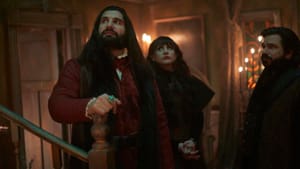Stay in the Loop
BSR publishes on a weekly schedule, with an email newsletter every Wednesday and Thursday morning. There’s no paywall, and subscribing is always free.
My favorite murderers
Here’s why everybody should watch FX’s ‘What We Do in the Shadows’

Though the superb writing, excellent acting, and fabulous design set FX’s What We Do in the Shadows apart from other television series, the way it handles its universally queer characters’ sexuality is what really makes the show stand out in both mainstream and queer TV and cinema. (Don’t worry, no major plot spoilers here.)
What We Do in the Shadows is based on the 2014 film of the same name, codirected and cowritten by costars Jemaine Clement (Flight of the Conchords, Moana) and Taika Waititi (Jojo Rabbit, Thor: Ragnarok, Hunt for the Wilderpeople). The TV series follows the misadventures of a household of vampires in Staten Island. Echoing the mockumentary style of the original Shadows movie, the show’s format, humor beats, interview asides, and dead-eyed stares directly into the camera make it feel like a more inclusive, supernatural version of The Office.
We follow three out-of-touch vampires of the traditional blood-sucking variety: Nandor (Kayvan Novak), Nadja (Natasia Demetriou), and Laszlo (Matt Berry); alongside their more modern day-walking “energy vampire” roommate, Colin Robinson (Mark Proksch). Also in residence is Nandor’s human familiar, Guillermo (Harvey Guillén). Contending with both the human and supernatural worlds, the household’s dealings reveal mixed but always funny results.
Unbury your gays
There is little queer visual media that could be categorized as happy or fun—it’s a genre notorious for being so depressing that even the few uplifting stories inevitably tend to spend significant time focusing on queer angst and pain. Shadows avoids the stereotypes that more conventional shows fall into because not only are all the characters well-written and nuanced in their own ways, but every single character is also pansexual, meaning they are capable of experiencing attraction to people of any and all gender identities.
“All of them. All of our characters are completely pansexual,” confirmed Paul Simms, a writer, co-showrunner, and executive producer of the series. This is frankly unheard of in mainstream media (and especially for the pan community, which most people don’t know even exists), and I’m absolutely thrilled with the show creators’ unwavering commitment to, and respect for, their queer characters and audiences.
Inherent queerness
While sexuality and the specific axis of each character’s identity is never overtly discussed, it’s nevertheless addressed throughout the series in a refreshingly cavalier manner. For example, Nandor and Guillermo’s relationship has obvious homoerotic undercurrents and a sense of attachment that’s noted for being an unusually close vampire/familiar relationship. Meanwhile, Guillermo has flirtatious moments with another male familiar; Nadja details her centuries-long affair with her human lover, Gregor (Jake McDormand), who in his many reincarnations takes many forms, including those of women; and Laszlo’s long history of pornographic acting with companions across the gender spectrum is revealed with little fanfare. There’s even “The Orgy,” an entire episode dedicated to the household’s preparation to host the biannual vampire orgy—the assumed queerness of the event is quite literally its least interesting detail.

Even better, not only are the characters queer, but some of the actors are, too. Guillén and guest star Evan Rachel Wood are two queer actors who appear on the show, and Guillén has gone on record several times, embracing the fact that the show eagerly leans into the inherent queerness of vampirism. “I love being part of a show [where] it's great that everyone's queer, that all the characters are queer. But it's not the focus,” Guillén said in an interview with The Advocate.
Lovably bad
Shadows is an excellent example of where the line lies between the gay villain trope (portraying only awful, villainous characters as queer) and characters who do objectively bad things and are also, unrelatedly, queer—in part because if everyone is queer, queerness cannot be limited to antagonists. Horror and comedic elements are often sourced from the same material. Yes, vampires are dangerous creatures who regularly murder humans and have corpses littered around their home, but this is balanced with the characters’ likability, and the hilarity of Guillermo sourcing virgins from CrossFit Gyms: “No one’s touched them…because they won’t shut up about CrossFit.”
Honestly, it’s hard not to love three bloodsucking goofballs (and their boring-on-purpose roommate) who make glitter self-portraits for their familiars and immediately panic when they fall for an email-forwarding scam about Bloody Mary. But who can blame them? In a world full of vampires, cursed hats, witches, tenuous truces with werewolves, and vampire hunters, I can see where they’re coming from just as much as I’m laughing at their total lack of awareness of the past couple decades (or centuries). The show is a rare gem: marvelous in every way; clever, funny, and unique (fortunately, a third season is on the way). And the fact that everyone just happens to be queer in a way that’s normalized and respectful is the cherry on top.
Image description: Three TV vampires, played by Kayvan Novak, Natasia Demetriou, and Matt Berry, stand looking anxiously upward at the bottom of a staircase. They all have long, heavy, black hair and ornate, layered outfits.
Image description: The vampire Nandor stands next to his human familiar Guillermo in a cluttered, ornate room. They are both wearing long sleeves and dark vests and are looking meaningfully at each other.
What, When, Where
What We Do in the Shadows. Created for television by Jemaine Clement. Seasons one and two are streaming on Hulu. Closed captioning is available.
Sign up for our newsletter
All of the week's new articles, all in one place. Sign up for the free weekly BSR newsletters, and don't miss a conversation.

 Mina Reinckens
Mina Reinckens